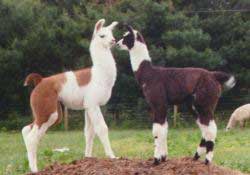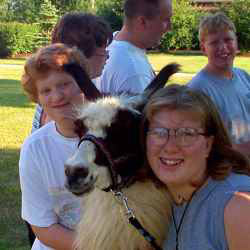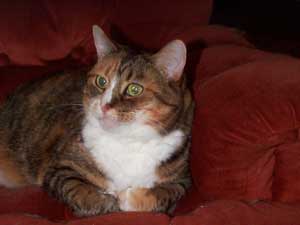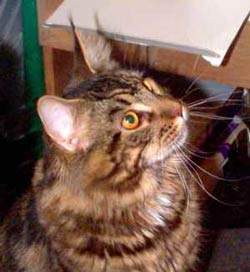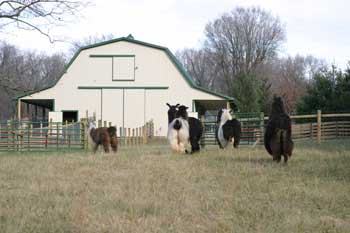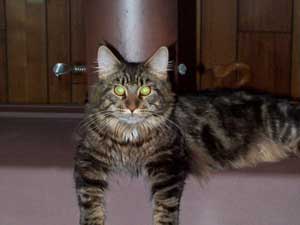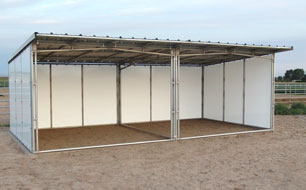 Housing for llamas can be simple sheds to elaborate barns. The basic winter requirements are shelter from inclement weather (rain, snow) and wind protection, which can be provided by as little as a three-sided shelter with the open side facing away from the prevailing wind. More substantial shelter may be required during severe (below zero degrees Fahrenheit or colder) or prolonged cold spells. Supplemental heat is rarely required for healthy adult llamas in US climates, although a thick bed of straw will add considerably to the llamas’ heat retention capabilities.While the simple shelter is necessary to protect from rain, the added danger of summer heat requires a source of shade in a well-ventilated area. Shearing of the llamas’ wool, the use of fans, and small ponds of cooling water (such as kids’ plastic wading pools) can be invaluable in reducing the risk of heat stress. In most US climates, the danger of heat stress in summer is far greater than danger from cold conditions in the winter.
Housing for llamas can be simple sheds to elaborate barns. The basic winter requirements are shelter from inclement weather (rain, snow) and wind protection, which can be provided by as little as a three-sided shelter with the open side facing away from the prevailing wind. More substantial shelter may be required during severe (below zero degrees Fahrenheit or colder) or prolonged cold spells. Supplemental heat is rarely required for healthy adult llamas in US climates, although a thick bed of straw will add considerably to the llamas’ heat retention capabilities.While the simple shelter is necessary to protect from rain, the added danger of summer heat requires a source of shade in a well-ventilated area. Shearing of the llamas’ wool, the use of fans, and small ponds of cooling water (such as kids’ plastic wading pools) can be invaluable in reducing the risk of heat stress. In most US climates, the danger of heat stress in summer is far greater than danger from cold conditions in the winter.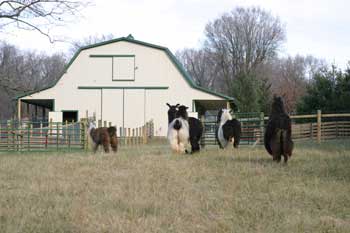
fred
(Note: ALSA is the Alpaca Llama Show Association, the national organization for consistency and tracking of llama & alpaca shows. They are one of the primary promoters for llamas, and provide the consistent basis for show standards that promote the breeding and training of fine llamas. ALSA’s contributions to llamas is indisputable. This article is meant for entertainment purposes only, although serious responses from ALSA judges and show organizers is encouraged.)
Buster, on the right, at two weeks old, with all his original legs!
While many of our other llamas have attended llama shows throughout the region, we have yet to take Buster. Buster is a friendly, well-mannered three year old gelding who goes to many functions with us, such as visits to kids homes, and entertains disabled visitors as well as family, friends, and school children here on the farm. Everyone who meets Buster remembers him, and many have received one of his warm, special “llama hugs” for which he is famous. Despite his easy handleability and calm nature however, he has never had a chance to compete in a show. Buster, you see, only has three legs.
We have longed to take Buster to a show, and demonstrated what a real “public relations” llama can do. Despite his disability, and maybe even because of it, he fills this role perfectly. Many disabled children see Buster’s courage, and are inspired; as are almost all who see him. He runs and plays with the other “boys,” hops in the trailer, balances for toe nail trims and can even teeter-totter on his two front legs to scratch his belly with one back foot! But taking a three-legged llama to a competitive show? This has seemed a little too much. Buster at the Damar center; he is the best PR llama ever!
We have tried to consider how we could do this, and decided that the problem was the “competition” of the show ring. Of course showing is competitive; but llamas are also just plain fun, and a joy to be around. No one demonstrates this more than Buster, who always will give me a special hug when I need one. Maybe if we enter him in a non-competitive nature, we could just have fun and share this unique fellow with everyone. Just for fun, we thought we would explore how ALSA show venues might accommodate a llama with disabilities.
PR Obstacle course: the obvious choice for Buster, as this course is designed to demonstrate a llama’s ability to cope with typically man-made “obstacles” that he might encounter at a school, nursing home, etc. While llamas are generally not asked to jump large hurdles in this course, occasionally a jumping hazard is included. We have had Buster jump small hurdles, but would prefer to let him walk or hop over such an obstacle, to save unnecessary stress on joints and tendons. Steps are difficult, but doable. Also backing up steps, a popular obstacle in the more advanced classes, is more of a challenge for Buster, but perhaps he could just take the faults on these, and be there to participate and enjoy, not compete for prizes. His prize is what he gives to others, not whether he can negotiate every imaginable obstacle. My main objective would be that Buster is judged fairly. We wouldn’t want him to place because of a “sympathy vote,” but at the same time, the obstacles are by and large more difficult for him to negotiate too. How would a judge handle this? Perhaps we could not compete at all, but simply do a demonstration after the class? Or are there enough “special” llamas out there that they could have a class of their own someday? Sort of a “Special Olympics” for llamas!
Halter class, non-breeding llama: Now here is a good one! A non-breeder halter class has always been a contraction to me. Llamas are altered (gelded or spayed, or otherwise prevented from breeding) because of one or more characteristics that render them less desirable for breeding. These could be conformational flaws, or something as inconsequential to the animal’s fitness as the amount, quality, or placement of the wool. In fact, non-breeder classes lump all wool classes together, so that short-wooled llamas, the type often gelded by long-wool breeders, are judged side by side with long, flowing wool beauties. To then compare and grade animals that have been previously determined to be flawed, seems strange indeed, especially considering preferences for wool type. Most animals even with poor conformation, short necks, or poor setting of the ears or tail can lead long, prosperous lives. They just do not carry the traits that are considered desireable for the breed. It would seem that this venue might encourage people to geld a near-perfect stud animal, thereby being assured of taking the awards in this class. A large farm with a lot of profit potential can afford to sacrifice such a llama for this purpose, and certainly there is a case for abuse of what this class is intended to be. I do not believe this practice is common, and would certainly be frowned upon by most breeders with a sense of fair play. Since a precedent in other animal shows also has been set for “pet” classes, I suppose one needs to just go along with the judging criteria. The judge does evaluate the llama on handleability and calmness to some degree, often petting the llama or asking the owner to lift its feet. A llama of excellent conformation however will rarely loose more than one placing in the final standing for failure to be handled easily.
Now how does Buster fit in to this? Certainly he is handleable, and has three very straight legs, and nice features such as ears, balance, and quality wool that would have perhaps made him a stud prospect for someone. His size and bone structure are smaller than either his sire or dam, leading me to believe that his early injury and trauma may have affected his growth. But how do you judge a llama on movement when he hobbles about on three legs? How would the judge handle this? Any judges out there care to comment? What would YOU do if I entered Buster in your class?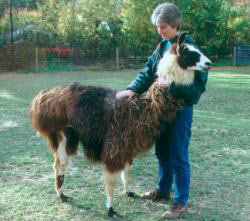
Fun stuff: At most shows there are some fun classes, that are not ALSA sanctioned, but are designed to challenge the owner and llama and entertain the crowds. Perhaps some of these would be places that Buster can show off!
buster_497.jpg (14290 bytes)
Buster at one year old, enjoying a good scratch.
Limping Llama contest; This is a variation of the Leaping Llama contest, where llamas are required to leap a hurdle of ever increasing height, until all the llamas have been eliminated except one, the winner! Now Buster cannot jump high buildings with a single bound, so we need a Limping Llama contest, where he would be a sure-fire winner!
Orgling contest: In this venue, people, not llamas, compete to see who can imitate the llama’s orgle, the sound made when male llamas are engaged in amorous pursuits. Buster, however, can orgle on command. We discovered this quite by accident. He was scratching his belly with his one rear foot, balanced with head down on his two front feet. We wondered if he could get in a “good scratch” that way, and endeavored to scratch all the areas underneath his chest and belly that he could not reach himself. He really enjoyed this, and soon began making orgling sounds! When you stop scratching him, he looks at you as though to ask you not to stop! After a good hug, he always gets a nice belly scratch, for which he emits a few appreciative orgles. Now if we can get him to orgle the Star Spangled Banner, like last year’s winner at the Indiana State Fair, we’d have this class licked! Click here to hear Buster!
Costume class: We can get a little crazy here! Of course, that is what everyone does! The peg-leg pirate, the 6 Million Dollar Llama, what suggestions do you have?
Oozie walks across my pillow, purring loudly, as though on an imperative mission to my bedside table. Other than to paw my loose earrings, scattering them on the carpet for the vacuum to hungrily discover, I know that her only real mission is to awaken me. If her soft pads on the pillow, inches from my head, and loud motor briefly next to my ear does not do the trick, she will circle round and come perilously close to my face. Her whiskers will “accidentally” brush my cheek, and when my eyes flash open, she will look at me as though to say, “are you awake? Well, since you are, how about getting up and letting me out?” Yes, I know her tricks. She is bound not to let me sleep too late on my “day off.”
I pack my 40 hours a week of my job “outside the home” into the first four days, in order to have Friday off. I’ve argued about this so-called “day off,” as it is really only the accumulation of all the evenings that I missed by working late. It is a law of physics that you don’t get something for nothing, a conservation of energy, and in this case, a conservation of time. Indeed, there is no making more time in a given week than what is available to everyone else. I just prefer to have it all at once, with the monotonous work week behind me and a three day weekend ahead. However, all those chores are saved up and must be done on Friday, rather than spread out through the week.Oozie revs her motor by the closed bedroom door, staring longingly at the doorknob, directing my attention to it, willing me to open it. She taught me this trick many years ago, and it is the reward for allowing me to sleep just an hour or so more after my husband rose at 4 am to leave for work. Oozie, as well as the other cats that own the house we care-take, are quite adept at training humans.
I stumble out of bed in the gloom, pausing to pull on a pair of sweats and one of my husband’s flannel shirts. Oozie is switching her tail impatiently. Once the door is open, Oozie accelerates out, and I follow her fat waddle down the stairs. I ask her when the kittens are due. She stops on the landing, glaring back, as though to say that her humans are not as svelte as they used to be, either.
She waits downstairs by the next closed door, that to the utility room, or cat room, as it has come to be called. I open the door, and she crouches against the onslaught as four cats push out at once. These are the late comers, the “kittens,” the hooligans that will not allow you a night’s sleep if allowed the run of the house. They have their own tidy little litter boxes, feed, cat trees, and variety of improvised sleeping places on the fridge, washer, dryer, and in the storage cabinets. They are an eclectic combination of red stripes, a calico, and a dark tiger. The undisputed leader is a still-growing male Maine Coon cat named Toes.
Oozie makes her way to the communal feed dish, and I go out in the garage to feed the outdoor cats, Gus and Bryant. More strays. Of the seven cats, only Toes was not a rescue, a stray, or an orphan that was forced upon us with a story of woe and dispair that I could not turn my back on. All are neutered or spayed, and live together in relative peace, as cats of leisure are prone to do.The feed dish in the garage is completely clean, and the water bowl, full last night, is also dry. A sure sign our raccoon friend has been here. I have trapped several ‘coons, and ferried them unceremoniously to the state forest, to begin life anew away from the free meals afforded in relative suburbia. I recall one evening watching four baby raccoons make their way in loose formation to the cat door in the garage. While cute at that age, some of these wild visitors have proven to be quite destructive. The current ‘coon seems to take what is offered easily, and leave without even tearing through the empty feed bags. Perhaps he is just happy to get his share of the high-priced, name brand urinary-tract-health cat food that he has become accustomed to. (This is certainly better than the whole tube of cat hair ball remedy-a certain laxative—that one hungry coon devoured one night!) I haven’t gotten motivated to set the live trap and prepare for another journey to liberate our uninvited guest.
I go back in the house, and make my way to the computer room. I am amused that I can say that; time wasn’t too long ago when computer rooms only existed in high-tech industrial buildings. Now most residences, and certainly anyone reading this over the internet, has a room that they might dub the computer room. In our case, five PC’s raise the temperature of the converted small office space to a cozy degree that can only be rivaled when the wood burning stove is in full roar.
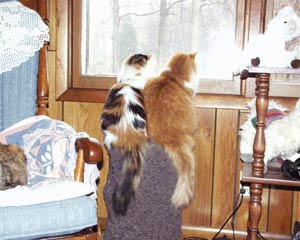
Linus and Peepers
Linus and Peepers: web page critics
Linus creates an intentional obstacle to my path, throwing himself on his side directly in front of me. I step over him, only to have to pause as Ringo, a cat who is blind in one eye, proceeds to make two quick clockwise circles in front of me, unsure of which way to go to avoid my feet. Having crossed the feline mine field, I finally reach my PC and sit down. I become a cat magnet.
Toes is instantly in my lap. He is not a cat; he is a presence. Accurate mousing is impossible, as he pushes my forearm for attention. Linus has lept to the printer, and with his soft pads against the klixon control panel, reset the printer in an error mode before moving up to the riser on my desk. Peepers, the calico, sits patiently by my feet. She knows Toes will soon grow bored, and she, the true lover, can come into my lap and purr herself to sleep while I try to type one-handed on the computer.
I awkwardly peruse my email, and sort through the list serv mail that threatens to bog down the server if not read daily. This is usually the best part of the day; quiet, surrounded by these little felines that want all my attention. Yet today, although it is still dark and cold outside, I am somehow impatient to start the day. I shut down the modem, and boost Peepers from my lap. I slip on a pair of low-cut rubber boots over bare feet, and my Carhart jacket over the long tails of my flannel shirt. I sneak outside to check the llamas in the predawn light.
They are just starting to stir, and seeing me approach, they rise from their warm spots, frost on their backs, and do their morning stretches. As I walk across the pasture, they come up to me. I pause, as crias find breakfast from their moms. When I seem to have everyone’s attention, I walk out and open the gate to the far pasture. They have followed me, and are pressed close, rushing into the pasture as the cats rushed out of the cat room this morning. And like the cats, in a mere few yards, they slow, wondering why they were in such a hurry to get here.
I stop by the gate a few minutes, and scold Max, the German shepherd/Chow mix that belongs to our good neighbors Pam and Rich. Max knows the routine, but he feels it is his duty to announce the arrival of the llamas, and particularly my presence in the pasture. He knows my voice and quickly quiets down, though his ruff remains raised and he remains alert. The llamas pay no heed to their neighbor dog, as they know he will not venture through the electric fence around their pasture. Woe to a strange dog, however; I’ve seen the llamas chase along the fence as a dog passed down the road, and watched unnerved as even Gus and Bryant came close to leaving this world at the stomping feet of Kodacolor, our most aggressive guard llama.
The boys, consisting of our senior stud Curry and several youngsters, watch longingly by the fence as the girls move farther away. Curry makes a plaintive hum, more like a whine, ending in an upward, questioning note. I’ve investigated extending the boy’s pasture along the narrow lane between the girl’s fence and the edge of the ravine, in order to allow the boys to follow the herd in their meanderings back and forth between the near and far pastures. The difficulty of installing fencing in this hard to maneuver area has prevented me from asking Paul, our “fence man,” from giving me an estimate on the work. That is if he even wants to attempt it.
I grow cold in my slightly underdressed garments, and head back to the barn. The llamas watch, and a few follow me. They know it is not feeding time, but perhaps I have a treat hidden in my pockets. Either that, or I am the only fresh entertainment they have had recently during this bleak, early winter gray weather.
As I close the gate behind me, I see several sets of perked ears atop long extended necks; llamas straining at the fence to see me leave, as though beckoning me to come back and play. What do they want? Probably food. Maybe not; maybe something more. Although most my llamas give you a look, as though they only condescend to having a halter put on, they almost always seem to enjoy the walks around the pond and woods. I really think they enjoy my company. They seem to enjoy certain visitors too; some people they just become at ease with almost from the start. After an initial wariness, they will allow strangers to scratch their backs, seeming to nudge them to the best spots. Many of these people, though animal lovers, have never been so close to a llama before. They comment that they can’t believe how I can come right up to them, and handle them. Then, when they can do the same, they begin to realize the joy that comes from knowing these special, gentle creatures.
I turn my back on my buddies, heading back to the house. I have umpteen litter boxes to clean, and the trash to take out before the trash man cometh. Then a sink full of dishes and the usual house cleaning. Well, a half-hearted attempt at house cleaning, anyway. I will spend more time cleaning out the barn (now that the llamas starting pooping in there again since the last snow!) than I will the house. At some point I will wear down and take a nap; but it will have to be coordinated with the cat’s nap time; otherwise, their tearing around will wake me up. A long winter’s nap, with Ringo on my stomach, sounds rather good about now, and makes Fridays worth the wait.

